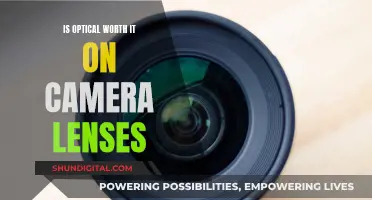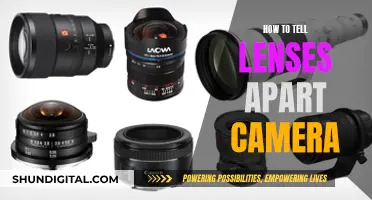
Camera lenses are an essential component of photography, as they are responsible for focusing light onto the camera's image sensor. The choice of lens can significantly impact the final image, and photographers have a wide range of options to choose from. The two main categories of lenses are prime and zoom lenses, with prime lenses offering a fixed focal length and zoom lenses providing variable focal lengths. While prime lenses were once considered sharper, modern zoom lenses have closed the gap, offering comparable image quality.
The advantages of prime lenses include their sharpness, compact size, and lower price. However, they offer less flexibility as the photographer needs to adjust their distance from the subject to change the framing. Zoom lenses, on the other hand, provide the convenience of adjusting the composition by zooming in or out. They are also ideal for travel and events where carrying multiple lenses may be impractical.
Beyond the prime and zoom categories, there are various types of lenses available, each serving a specific purpose. Wide-angle lenses offer a broader field of view, making them suitable for landscape and real estate photography. Telephoto lenses are perfect for capturing distant subjects, such as in wildlife or sports photography. Super-telephoto lenses provide even greater reach, allowing photographers to capture extremely distant subjects. Macro lenses facilitate close-up photography, enabling photographers to capture small details and objects.
The choice of lens ultimately depends on the photographer's needs and preferences. While some photographers may find a single lens sufficient, others may prefer to build a collection of lenses, known as the holy trinity, which typically includes an ultra-wide-angle zoom, a standard zoom, and a telephoto zoom.
What You'll Learn

Prime vs Zoom lenses
A prime lens has a fixed focal length, meaning it has a set angle of view that cannot be changed. The only way to change the size of your subject in the frame is by physically moving closer or further away. Prime lenses come in all kinds of sizes and focal lengths, from fisheye to super-telephoto.
A zoom lens has a variable focal length. By turning the zoom ring, you move the optical elements inside the lens to change the angle of view. This means you can make objects appear larger or smaller without having to move. Zoom lenses have two specifications that represent the two extremes of the zoom range, like 70-200mm. Such a lens may act as a 70mm focal length lens, a 200mm focal length lens, or anything in between.
Advantages of Prime Lenses
- Prime lenses are generally cheaper than zoom lenses.
- Prime lenses are often smaller and lighter than zoom lenses.
- Prime lenses offer superior image quality, with sharper images and better low-light performance.
- Prime lenses can provide a shallower depth of field, resulting in beautiful "bokeh" effects.
- Prime lenses can help you learn composition and find better angles by forcing you to "zoom with your feet".
Advantages of Zoom Lenses
- Zoom lenses offer versatility, allowing you to quickly change focal lengths without having to move or switch lenses.
- Zoom lenses often have image stabilization, allowing you to get sharp images even in low-light conditions.
- Zoom lenses can reduce weight and the need to carry multiple lenses, as a single zoom lens can replace two or three prime lenses.
Prime Lens vs Zoom Lens: Which Should You Get?
The choice between a prime and a zoom lens depends on your specific needs and preferences. If you want very shallow depth of field and beautiful bokeh, a prime lens is ideal. If you need versatility, such as when travelling or shooting weddings, a zoom lens is a better choice. Ultimately, both types of lenses have their advantages and can produce amazing images, so the decision comes down to your personal style and requirements.
DX Lenses: Compatible with FX Cameras?
You may want to see also

Wide-angle lenses
A lens is generally considered wide-angle when its focal length is less than 35mm. This translates to an angle of view greater than 55° across the photo's widest dimension. Focal lengths between 35mm and 24mm are considered standard wide-angle, while those below 16mm are ultra-wide-angle.
Another result of using a wide-angle lens is greater apparent perspective distortion when the camera is not aligned perpendicularly to the subject. For example, buildings appear to fall backward when the camera is pointed upward from ground level.
- Get much closer to the foreground and physically immerse yourself among your subjects.
- Carefully place near and far objects to achieve clear compositions.
- Point your camera at the horizon to avoid converging verticals.
- Be aware of how edge and barrel distortion may impact your subject.
In conclusion, wide-angle lenses are powerful tools that provide options not possible with other lens types. They can pose challenges, and it is important to feel comfortable using them without overthinking it.
Recognizing Sigma Camera Lenses: A Quick Guide to Identification
You may want to see also

Telephoto lenses
While telephoto lenses offer many benefits, such as increased magnification and the ability to capture scenes from a distance, they also have some drawbacks. One disadvantage is their size and weight, especially for budget-friendly options and lenses in the super telephoto range. Additionally, telephoto lenses can suffer from atmospheric haze and a "mirage" effect when photographing distant subjects, resulting in blurry images.
When considering purchasing a telephoto lens, it is essential to evaluate your specific needs and interests. If you are primarily interested in landscape photography, a shorter telephoto lens or a different type of lens may be more suitable. However, if you also want to capture wildlife or are interested in compressed shots, a super telephoto lens could be a valuable addition to your kit.
Camera Contact Lenses: Fact or Fiction?
You may want to see also

Super-telephoto lenses
The most important feature of super-telephoto lenses is their focal length, which refers to the ability of the lens to photograph and record images from an extremely long distance. These lenses typically have a focal length longer than 300mm, with some prime lenses offering a focal length of up to 800mm. Zoom lenses, on the other hand, tend to top out at around 600mm.
Another important feature to consider when purchasing a super-telephoto lens is the aperture. Lenses with a larger aperture, such as f/2.8, tend to be significantly larger and more expensive than those with a smaller aperture, such as f/4. Additionally, zoom lenses typically feature variable apertures, which keep the overall lens size down, while some lenses offer a constant maximum aperture, such as the Nikon AF-S NIKKOR 200-500mm f/5.6E ED VR lens.
Image stabilization is also a key feature of super-telephoto lenses, as it helps to reduce camera shake and improve handheld shooting. Many super-telephoto lenses also offer multiple image stabilization modes, such as panning and handheld shooting, to improve stability when tracking horizontal motion.
When choosing a super-telephoto lens, it is important to consider the sensor size of your camera, as APS-C and Micro Four Thirds cameras have inherent crop factors that will effectively extend the equivalent focal length. This can be advantageous for sports and wildlife shooters, as it provides more reach and allows for a lighter setup.
Some popular super-telephoto lenses on the market include the Canon RF 600mm f/11 and RF 800mm f/11 IS STM lenses, which offer incredible reach and image stabilization at a very affordable price. The Sony FE 400mm f/2.8 GM OSS lens is another great option, offering a fast aperture of f/2.8 and excellent optical image stabilization. For mirrorless cameras, the Sigma 150-600mm f/5-6.3 DG DN OS Sport lens offers stunning optics and optical stabilization in a lightweight package.
Stealth Trail Cameras: Do They Have Lenses?
You may want to see also

Macro lenses
For example, short macro lenses are lightweight, inexpensive, and easy to store and carry, making them suitable for casual macro photography. However, they have a reduced working distance, which can be problematic when photographing insects, as you need to get extremely close to the subject. Midrange macro lenses, on the other hand, offer a perfect working distance for flower photography, providing a balance between closeness and flexibility. They are also relatively lightweight and can often be found at reasonable prices. Long macro lenses provide exceptional working distance and image quality but tend to be heavy and expensive.
When choosing a macro lens, consider your specific needs and preferences. Factors such as physical requirements (handholdability vs. using a tripod), your preferred subject matter, and your desired style will influence your decision. While there is no one-size-fits-all macro lens, understanding the characteristics of each focal length category can help you select the ideal option for your macro photography endeavours.
The Importance of Pristine Camera Lenses for Perfect Pictures
You may want to see also
Frequently asked questions
Extra camera lenses can help photographers take better pictures of different subjects or in different circumstances.
Prime and zoom. A prime lens has a fixed focal length, while a zoom lens has a variable focal length.
Prime lenses are usually sharper, smaller, lighter, and less expensive than zoom lenses. However, you only have one focal length with a prime lens, so you need to move closer or further away from your subject to adjust your framing. Zoom lenses offer more flexibility in framing your image and can save you from having to buy and carry an extra lens.







